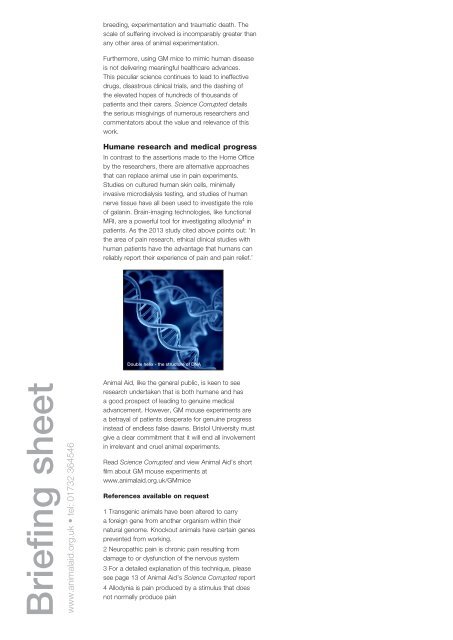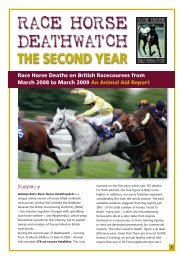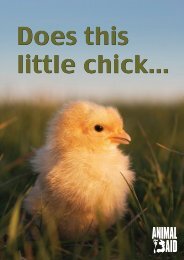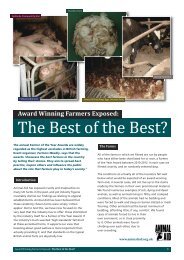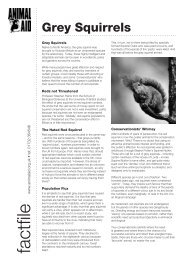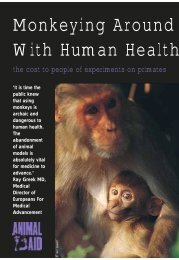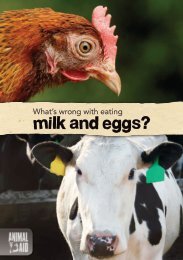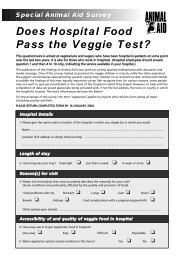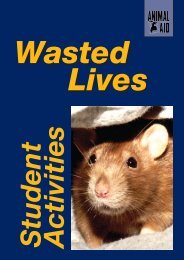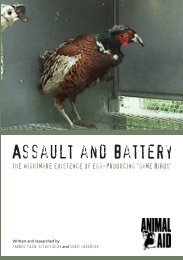Read Animal Aid's scientific Briefing on the Bristol experiments
Read Animal Aid's scientific Briefing on the Bristol experiments
Read Animal Aid's scientific Briefing on the Bristol experiments
Create successful ePaper yourself
Turn your PDF publications into a flip-book with our unique Google optimized e-Paper software.
eeding, experimentati<strong>on</strong> and traumatic death. The<br />
scale of suffering involved is incomparably greater than<br />
any o<strong>the</strong>r area of animal experimentati<strong>on</strong>.<br />
Fur<strong>the</strong>rmore, using GM mice to mimic human disease<br />
is not delivering meaningful healthcare advances.<br />
This peculiar science c<strong>on</strong>tinues to lead to ineffective<br />
drugs, disastrous clinical trials, and <strong>the</strong> dashing of<br />
<strong>the</strong> elevated hopes of hundreds of thousands of<br />
patients and <strong>the</strong>ir carers. Science Corrupted details<br />
<strong>the</strong> serious misgivings of numerous researchers and<br />
commentators about <strong>the</strong> value and relevance of this<br />
work.<br />
Humane research and medical progress<br />
In c<strong>on</strong>trast to <strong>the</strong> asserti<strong>on</strong>s made to <strong>the</strong> Home Office<br />
by <strong>the</strong> researchers, <strong>the</strong>re are alternative approaches<br />
that can replace animal use in pain <strong>experiments</strong>.<br />
Studies <strong>on</strong> cultured human skin cells, minimally<br />
invasive microdialysis testing, and studies of human<br />
nerve tissue have all been used to investigate <strong>the</strong> role<br />
of galanin. Brain-imaging technologies, like functi<strong>on</strong>al<br />
MRI, are a powerful tool for investigating allodynia 4 in<br />
patients. As <strong>the</strong> 2013 study cited above points out: ‘In<br />
<strong>the</strong> area of pain research, ethical clinical studies with<br />
human patients have <strong>the</strong> advantage that humans can<br />
reliably report <strong>the</strong>ir experience of pain and pain relief.’<br />
Double helix - <strong>the</strong> structure of DNA<br />
<str<strong>on</strong>g>Briefing</str<strong>on</strong>g> sheet<br />
www.animalaid.org.uk • tel: 01732 364546<br />
<str<strong>on</strong>g>Animal</str<strong>on</strong>g> Aid, like <strong>the</strong> general public, is keen to see<br />
research undertaken that is both humane and has<br />
a good prospect of leading to genuine medical<br />
advancement. However, GM mouse <strong>experiments</strong> are<br />
a betrayal of patients desperate for genuine progress<br />
instead of endless false dawns. <strong>Bristol</strong> University must<br />
give a clear commitment that it will end all involvement<br />
in irrelevant and cruel animal <strong>experiments</strong>.<br />
<str<strong>on</strong>g>Read</str<strong>on</strong>g> Science Corrupted and view <str<strong>on</strong>g>Animal</str<strong>on</strong>g> Aid’s short<br />
film about GM mouse <strong>experiments</strong> at<br />
www.animalaid.org.uk/GMmice<br />
References available <strong>on</strong> request<br />
1 Transgenic animals have been altered to carry<br />
a foreign gene from ano<strong>the</strong>r organism within <strong>the</strong>ir<br />
natural genome. Knockout animals have certain genes<br />
prevented from working.<br />
2 Neuropathic pain is chr<strong>on</strong>ic pain resulting from<br />
damage to or dysfuncti<strong>on</strong> of <strong>the</strong> nervous system<br />
3 For a detailed explanati<strong>on</strong> of this technique, please<br />
see page 13 of <str<strong>on</strong>g>Animal</str<strong>on</strong>g> Aid’s Science Corrupted report<br />
4 Allodynia is pain produced by a stimulus that does<br />
not normally produce pain


